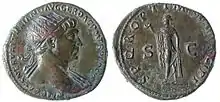Spes
Spes (Latin for "Hope") was worshipped as a goddess in ancient Roman religion. Numerous temples to Spes are known, and inscriptions indicate that she received private devotion as well as state cult.[1]

Republican Hope



During the Republic, a temple to "ancient Hope" (Spes vetus) was supposed to have been located near the Praenestine Gate.[2][3] It was associated with events that occurred in the 5th century BC,[4][3] but its existence as anything except perhaps a private shrine has been doubted.[5]
A well-documented Temple of Spes was built by Aulus Atilius Calatinus[6][3] along with Fides, as the result of vows (vota) made to these goddesses during the First Punic War.[7] This was built at the vegetable market (Forum Olitorium)[8] just outside the Carmental Gate. It was twice burnt down and restored, first in 213 BC and then again in AD 7.[9]
At Capua in 110 BC, a temple was built to the triad of Spes, Fides, and Fortuna.[10][3]
Imperial Hope
Spes was one of the divine personifications in the Imperial cult of the Virtues. Spes Augusta was Hope associated with the capacity of the emperor as Augustus to ensure blessed conditions.[11]
Like Salus ("Salvation, Security"), Ops ("Abundance, Prosperity"), and Victoria ("Victory"), Spes was a power that had to come from the gods, in contrast to divine powers that resided within the individual such as Mens ("Intelligence"), Virtus ("Virtue"), and Fides ("Faith, Fidelity, Trustworthiness").[12]
Greek Elpis
The Greek counterpart of Spes was Elpis, who by contrast had no formal cult in Greece. The primary myth in which Elpis plays a role is the story of Pandora. The Greeks had ambivalent or even negative feelings about "hope", with Euripides describing it in his Suppliants as "delusive" and stating "it has embroiled many a State",[13] and the concept was unimportant in the philosophical systems of the Stoics and Epicureans.[3]
See also
- Hope, the concept
- Piety (Pietas), Luck (Fortuna), Faithfulness (Fides) as Roman goddesses
References
Citations
- J. Rufus Fears, "The Cult of Virtues and Roman Imperial Ideology," Aufstieg und Niedergang der römischen Welt II.17.2 (1981), p. 837.
- Frontinus, De aquaeductu 1.19.
- Momigliano (1987), p. 75.
- Livy 2.51.2; Dionysius of Halicarnassus 9.24.4.
- Fears, "The Cult of Virtues," p. 848.
- Cicero, De legibus 2.28.
- Fears, "The Cult of Virtues," p. 835.
- . Encyclopædia Britannica (11th ed.). 1911.
- Burn (1871), p. 305.
- Inscriptiones Latinae Selectae 3770.
- J. Rufus Fears, "The Theology of Victory at Rome: Approaches and Problem," Aufstieg und Niedergang der römischen Welt II.17.2 (1981), pp. 812–814.
- Fears, "The Theology of Victory at Rome," p. 744.
- Euripedes, Suppliants, l. 479.
Bibliography
- Burn, Robert (1871), Rome and the Campagna: An Historical and Topographical Description of the Site, Buildings, and Neighbourhood of Ancient Rome..., Cambridge: Deighton, Bell, & Co.
- Momigliano, Arnaldo (1987), "Religion in Athens, Rome, and Jerusalem in the First Century B.C.", On Pagans, Jews, and Christians, Wesleyan University Press
Further reading
- Clark, Mark Edward. "Spes in the Early Imperial Cult: 'The Hope of Augustus'." Numen 30.1 (1983) 80–105.
